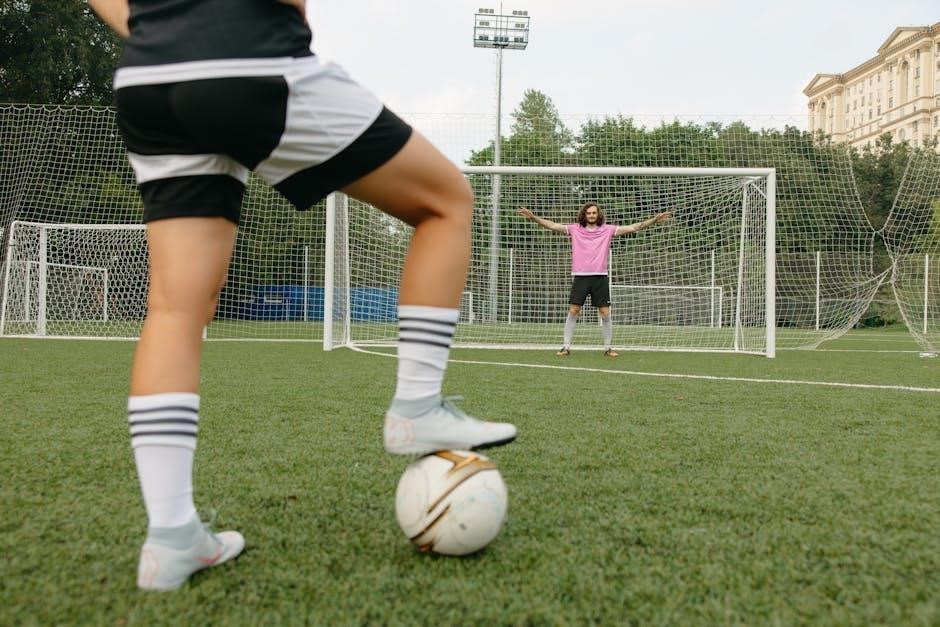Goalkeeper training drills are essential for developing technical, tactical, and physical skills․ They focus on shot stopping, handling, distribution, and positioning, enhancing confidence and game readiness through structured exercises․
Importance of Structured Goalkeeper Training
Structured goalkeeper training is crucial for enhancing technical, tactical, and physical skills․ It ensures consistency, focused practice, and gradual improvement, addressing specific areas like shot stopping and distribution․ By following a well-planned regimen, goalkeepers reduce errors, build confidence, and develop the mental and physical resilience needed for high-performance gameplay․ Regular, organized sessions also foster better decision-making and reaction times, enabling goalkeepers to excel in competitive environments․
Overview of Key Skills in Goalkeeping
Key skills in goalkeeping include shot stopping, handling, distribution, positioning, and footwork․ These skills ensure effective communication, confidence, and control․ Techniques like diving, catching, and parrying are fundamental, while agility and reflexes enhance reaction times․ Proper positioning narrows shooting angles, and accurate distribution restarts attacks․ Mastering these skills through structured drills builds a well-rounded goalkeeper capable of excelling in various game scenarios․
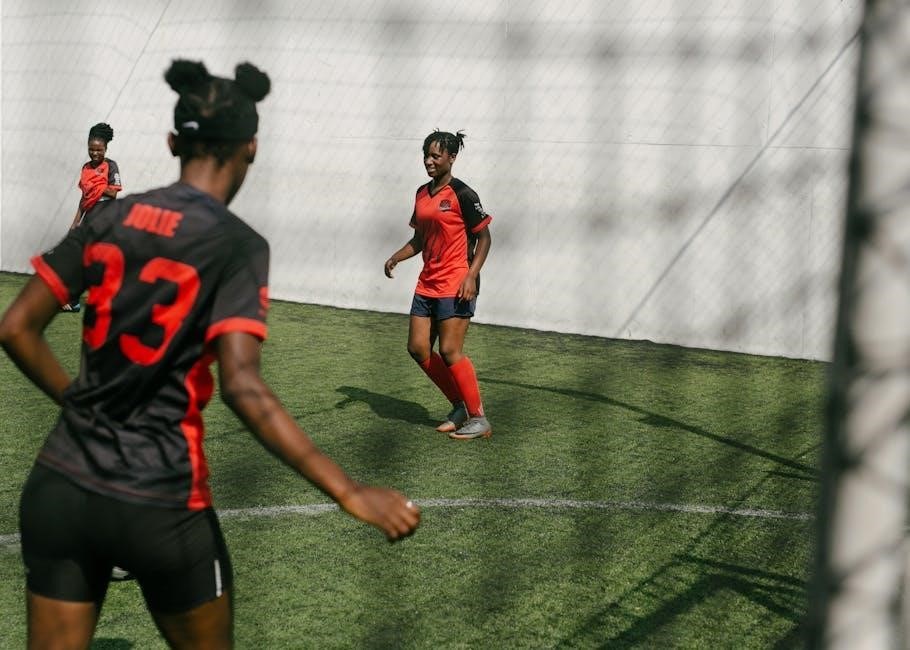
Key Skills in Goalkeeping
Key skills in goalkeeping include shot stopping, handling, and distribution, positioning, and footwork, ensuring effective communication and control․ These skills ensure effective communication, confidence, and control․
Shot Stopping Techniques
Shot stopping techniques are vital for goalkeepers to effectively prevent goals․ These include low diving, high diving, and reaction saves․ Proper body positioning and footwork are crucial, enabling quick reflexes and balance․ Drills like diving around cones and reacting to unexpected shots enhance these skills․ Goalkeepers must also master the art of narrowing angles and staying alert to minimize scoring opportunities, ensuring confidence and reliability in critical moments during matches․
Handling and Distribution
Handling and distribution are fundamental skills for goalkeepers, ensuring secure ball control and effective passing․ Techniques include catching, throwing, and rolling, with emphasis on accuracy and decision-making․ Drills focus on high ball claims, distribution under pressure, and quick releases to initiate counter-attacks․ These exercises enhance a goalkeeper’s ability to command the box and seamlessly transition from defense to offense, making them a vital asset to the team’s overall strategy and performance․
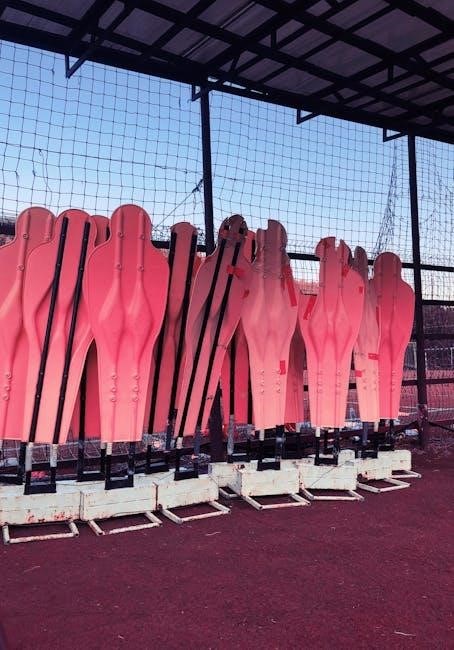
Warm-Up and Basic Drills
Warm-Up and Basic Drills focus on dynamic stretching and fundamental footwork, preparing goalkeepers for intense training by improving flexibility and coordination essential for match performance․
Dynamic Stretching for Goalkeepers
Dynamic stretching is crucial for goalkeepers to prepare for training and matches․ Exercises like leg swings, high knees, and arm circles improve flexibility and range of motion․ These movements mimic game actions, ensuring the goalkeeper is ready to dive, jump, and move quickly․ Incorporating dynamic stretches reduces injury risk and enhances performance by increasing blood flow and muscle activation․ Consistency in these routines is key for optimal readiness and mobility․
Basic Footwork Patterns
Mastering basic footwork patterns is fundamental for goalkeepers to maintain balance and positioning․ Drills such as carioca drills, ladder exercises, and cone weaves enhance agility and coordination․ These exercises focus on quick changes of direction, proper body alignment, and explosive movements․ By practicing these patterns, goalkeepers improve their ability to cover the goal effectively and react swiftly to opponents’ movements during a match․
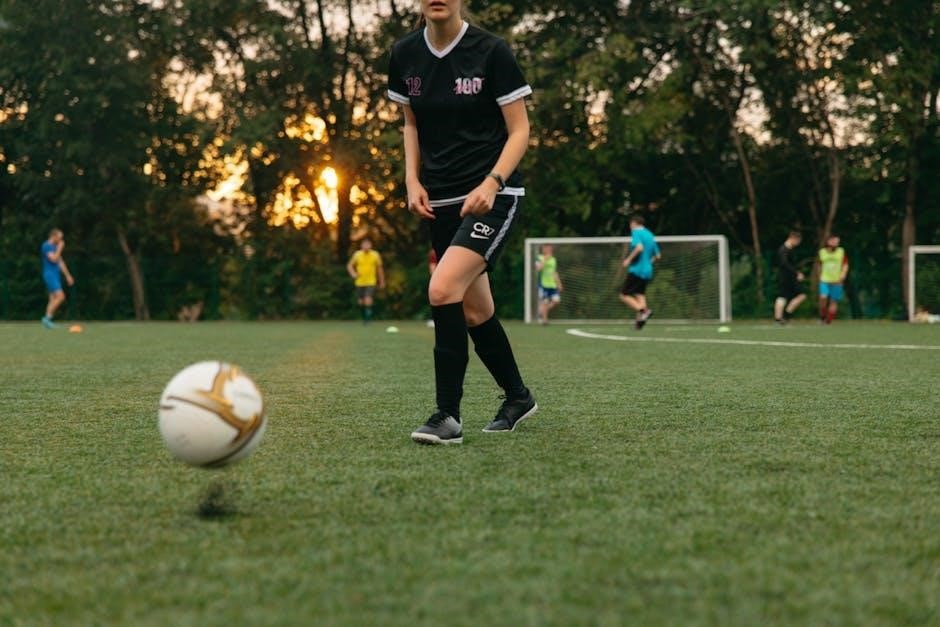
Footwork and Agility Drills
Footwork and agility drills enhance a goalkeeper’s ability to move quickly and precisely around the penalty area․ These exercises improve reaction time, balance, and coordination, essential for sharp turns and fast breaks, simulating game scenarios․
Cones and Flags for Quick Movements
Cones and flags are excellent tools for improving goalkeepers’ agility and speed․ Set up cone mazes or flag markers to create zigzag patterns․ Goalkeepers weave through, focusing on sharp turns and quick directional changes․ This drill enhances reaction time, footwork, and the ability to rapidly reposition․ Vary the layout and spacing to increase difficulty, ensuring goalkeepers stay nimble and prepared for rapid movements during matches․
Shuttle Runs and Ladder Drills
Shuttle runs and ladder drills are dynamic exercises that boost agility and speed․ Goalkeepers perform side-to-side movements through ladders or cones, focusing on quick foot transitions․ Shuttle runs involve rapid sprints between markers, improving acceleration and deceleration․ These drills simulate match scenarios, enhancing a goalkeeper’s ability to rapidly change direction and position themselves effectively during high-intensity plays, thereby improving overall performance and reaction time on the field․
Handling and Catching Exercises
Handling and catching exercises refine a goalkeeper’s ability to secure and control the ball․ Drills focus on high and low catches, ensuring consistency and confidence in all situations․
High Ball and Low Ball Catching
High and low ball catching drills improve a goalkeeper’s ability to secure balls at varying heights․ Using cones and balls, goalkeepers practice catching and positioning, ensuring quick reflexes and precise movements․ These exercises enhance confidence and consistency in handling aerial and ground-level threats during matches, providing a solid foundation for effective goalkeeping․
Receiving and Securing the Ball
Drills for receiving and securing the ball focus on a goalkeeper’s ability to safely collect and control incoming passes or clearances․ Using cones and balls, exercises emphasize proper footwork, body positioning, and hand placement․ These techniques ensure the ball is protected from opponents, allowing the goalkeeper to distribute it effectively․ Regular practice enhances confidence and reduces errors in match situations․
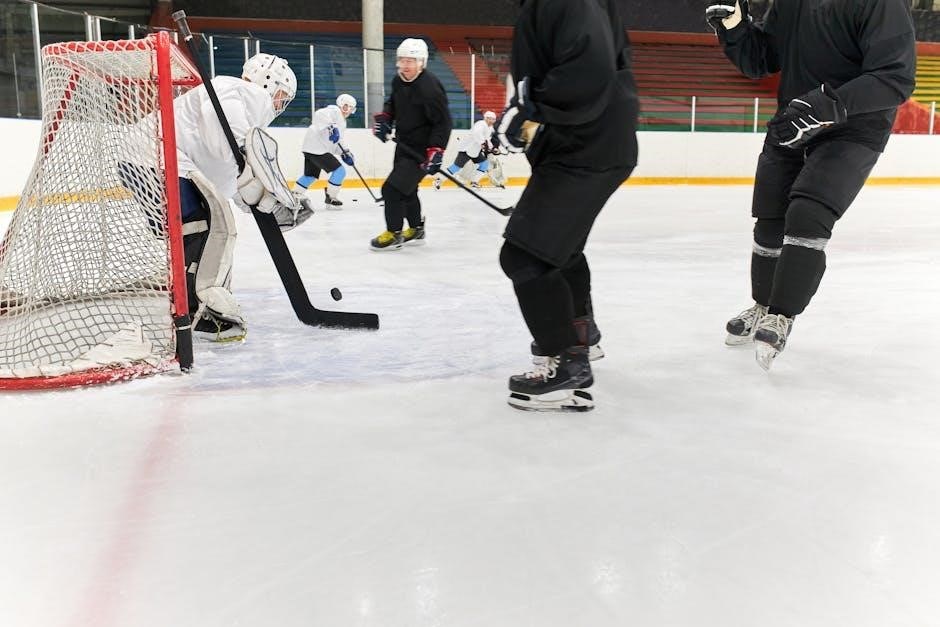
Positioning and Angles
Positioning and angles are critical for reducing scoring opportunities․ Goalkeepers learn to narrow the angle on attackers and adjust based on the ball’s location to maximize coverage and minimize threats effectively․
Narrowing the Angle on Attackers
Narrowing the angle is a fundamental skill where goalkeepers reduce the space between themselves and the attacker․ By positioning their body diagonally, they limit shooting options․ Drills focus on quick lateral movements and reading attackers’ intentions, ensuring the goalkeeper is always between the ball and the goal, effectively minimizing the opponent’s scoring chances through precise positioning and agility․
Positioning Based on the Ball Location
Positioning based on the ball’s location is crucial for goalkeepers to anticipate threats․ They must align their body with the ball, adjusting depth and angles to stay central and balanced․ Drills emphasize moving dynamically in relation to the ball, ensuring optimal coverage of the goal while maintaining visibility․ This strategy helps goalkeepers react effectively to various scenarios, enhancing their ability to make saves and control the defense․
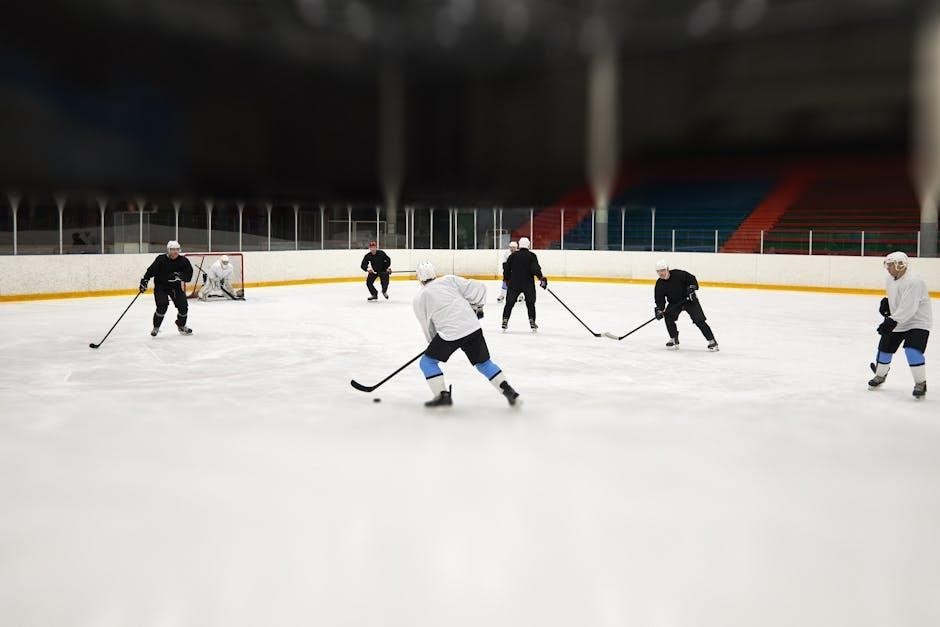
Reaction and Reflex Training
Reaction and reflex training enhances a goalkeeper’s ability to respond quickly to unexpected shots and dynamic situations, improving reaction time and overall agility in high-pressure scenarios․
Reaction Drills with Unexpected Shots
Reaction drills involve quick movements and unexpected shots to simulate real-game scenarios․ Goalkeepers practice rapid responses, improving reflexes and decision-making․ Drills include sudden ball servings, spins, and angled shots, challenging the keeper to react swiftly and effectively․ These exercises enhance muscle memory and readiness for unpredictable game situations, ensuring sharp reflexes and confident saves under pressure․
Reflex Saves and Quick Responses
Reflex saves focus on quick, instinctive reactions to high-intensity shots or crosses․ Goalkeepers practice rapid hand and foot movements to make split-second decisions․ Drills include sudden ball volleys, close-range shots, and dynamic footwork exercises․ These sessions enhance reaction time, improving the ability to make instinctive saves in high-pressure situations, ensuring sharp reflexes and reliable performance during critical game moments․
Agility and Speed Training
Agility and speed are crucial for goalkeepers to cover the field quickly․ Drills with cones, ladder exercises, and shuttle runs improve quick movements and sharp directional changes, essential for reacting to fast-paced game situations․
Zig-Zag Runs and Speed Ladders
Zig-zag runs and speed ladders enhance agility and quick footwork․ Goalkeepers weave through cones or ladder rungs, focusing on rapid directional changes and balance․ Drills improve reaction time and acceleration, essential for covering the field swiftly․ Variations include forward, backward, and lateral movements, simulating game scenarios․ These exercises are fundamental for developing the speed and agility needed to excel in goalkeeping․
Sprints and Acceleration Drills
Sprints and acceleration drills build explosive power and speed, crucial for goalkeepers to quickly move across the field․ These exercises involve short bursts of sprinting, often with resistance bands, to enhance acceleration․ Variations include hill sprints or cone drills, focusing on rapid starts and stops․ Such training improves reaction time and enables goalkeepers to cover ground swiftly, responding to dynamic game situations with confidence and effectiveness․
Game Scenario Simulations
Simulate real-game situations to prepare goalkeepers for match conditions․ Drills include breakaways, one-on-one scenarios, and crossing practices to enhance decision-making and reaction speed under pressure․
Breakaway and One-on-One Situations
Simulate high-pressure scenarios where goalkeepers face direct shots or one-on-one confrontations․ Drills involve attackers dribbling toward the goal, forcing the keeper to make split-second decisions․ Focus on positioning, narrowing angles, and quick reflexes to minimize scoring opportunities․ These exercises enhance confidence and reaction skills, replicating real-game intensity and preparing keepers for critical moments․ They also improve footwork and the ability to read attackers’ movements effectively․
Crossing and Corner Kick Practices
Drills focus on handling crosses and high balls in crowded areas․ Goalkeepers practice positioning, timing, and securing crosses․ Exercises involve simulated corner kicks, with emphasis on claiming high balls and organizing the defense․ These scenarios enhance decision-making and physicality, ensuring keepers can dominate aerial threats and distribute the ball effectively after securing possession․
Cross and Aerial Ball Handling
Cross and aerial ball handling are crucial for dominating high balls․ Techniques include claiming crosses, positioning, and timing jumps․ Proper distribution follows securing the ball effectively․
Claiming High Balls and Crosses
Claiming high balls and crosses is vital for dominance in aerial situations․ Goalkeepers must master timing, positioning, and confidence․ Drills involve cones and ladder setups to enhance agility and reaction․ Start with stationary high balls, progressing to dynamic crosses․ Focus on secure catches and balanced landings․ This builds confidence and reduces errors, ensuring command in the box during matches․
Dealing with Aerial Threats
Dealing with aerial threats requires precision and composure․ Drills focus on positioning, timing, and spatial awareness to intercept crosses and corners․ Use cones and flags for footwork, then progress to high-ball catches․ Emphasize reading the flight of the ball and securing it confidently․ These exercises build the goalkeeper’s authority in the air, reducing vulnerabilities during set-pieces and ensuring dominance in the box․
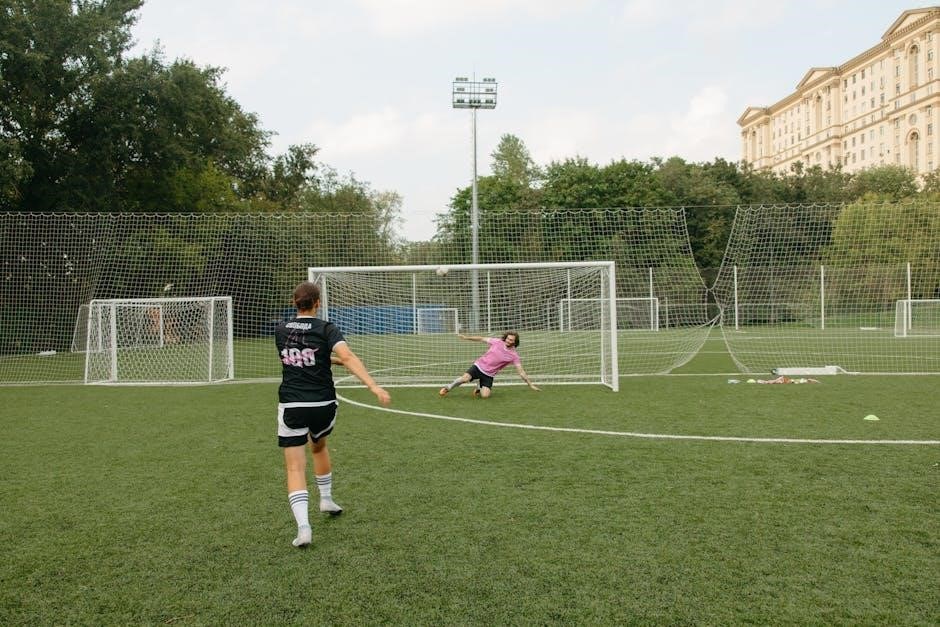
Distribution and Passing
Distribution and passing are crucial for maintaining possession․ Techniques include short passes, long throws, and rolling the ball․ These skills help goalkeepers initiate counter-attacks effectively․
Short and Long Passing Techniques
Mastering short and long passing is vital for goalkeepers to control the flow of the game․ Short passes involve precise, low-risk distribution to nearby defenders, while long passes require strength and accuracy to reach midfielders or forwards․ Techniques include using the inside of the foot for short passes and the laces for long, powerful kicks․ Drills focus on accuracy, power, and decision-making under pressure, ensuring effective ball distribution and maintaining possession․ Regular practice enhances a goalkeeper’s ability to dictate play and support the team’s offensive strategies confidently and consistently․
Rolling and Throwing the Ball
Rolling and throwing are fundamental skills for goalkeepers to distribute the ball effectively․ Rolling involves using the hands to push the ball across the ground with precision, while throwing requires strength and accuracy to reach teammates quickly; Drills focus on proper technique, such as using the fingertips for control and following through on throws․ These exercises improve distribution accuracy and speed, enabling goalkeepers to initiate counterattacks and maintain fluid gameplay seamlessly․
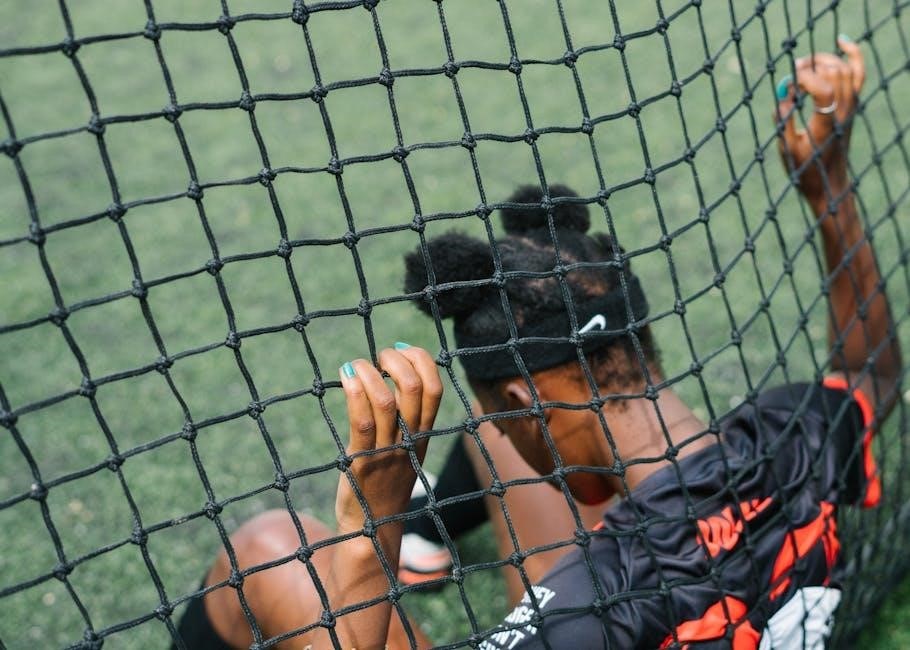
Mental and Tactical Development
Mental and tactical development focuses on improving a goalkeeper’s decision-making, focus, and game awareness․ Drills emphasize anticipation, positioning, and communication, enhancing the ability to read the game effectively․
Reading the Game and Anticipation
Reading the game and anticipation are crucial for goalkeepers to stay one step ahead․ Drills focus on identifying attacking patterns, predicting opponent movements, and making split-second decisions․ By studying body language and positioning, goalkeepers can anticipate threats, reduce reaction time, and command the defense effectively, ensuring better overall performance and leadership on the field․
Communication with the Defense
Effective communication between the goalkeeper and defense is vital for a solid backline․ Drills emphasize clear verbal commands, tactical instructions, and visual signals to organize the team․ This ensures coordination during set-pieces, aerial threats, and open play, fostering trust and reducing errors․ Proper communication enhances defensive unity and overall team performance, making it a cornerstone of goalkeeper training programs․
Technology in Goalkeeper Training
Technology enhances training with video analysis and specialized apps, providing detailed performance insights and personalized feedback to improve techniques and decision-making efficiently․
Using Video Analysis
Video analysis is a powerful tool for goalkeepers to study techniques and improve performance․ By reviewing game footage, players can analyze movements, decision-making, and reflexes in real-time․ This technology provides immediate feedback, helping to identify strengths and weaknesses․ Coaches can use video to demonstrate proper form and strategies, while advanced software allows for slow-motion analysis and angle comparisons․ It enhances training efficiency and supports focused skill development․
Goalkeeper-Specific Training Apps
Goalkeeper-specific training apps offer tailored drills, video tutorials, and progress tracking․ These apps provide personalized sessions, focusing on reflexes, footwork, and handling; They often include interactive exercises and analytics to monitor improvement․ Coaches and goalkeepers can access a variety of drills, ensuring comprehensive skill development․ Such apps are valuable for both individual and team training, enhancing technical and tactical abilities through structured, app-based workouts;
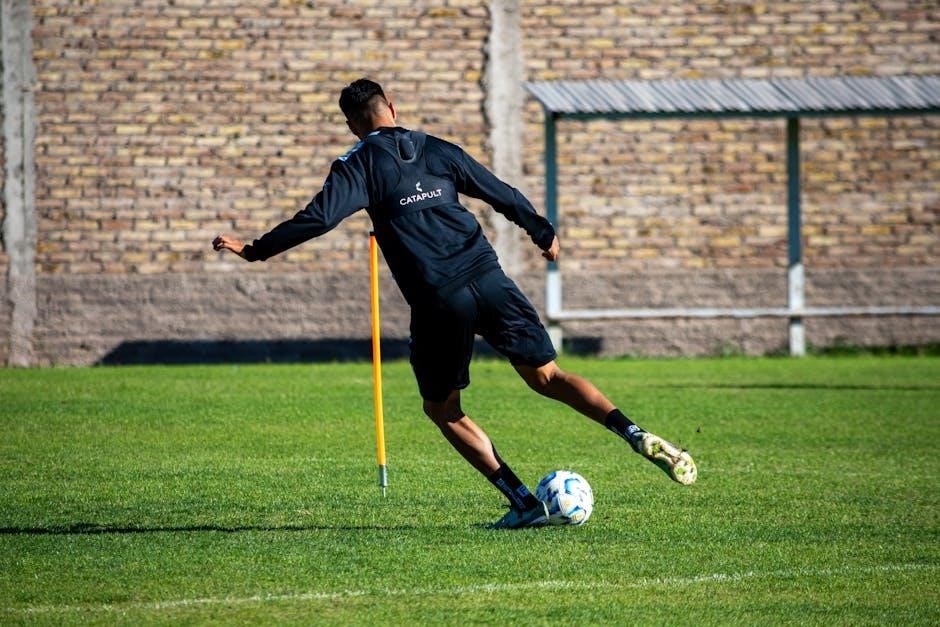
Cool-Down and Recovery
Cool-down involves static stretching and foam rolling to improve flexibility and reduce muscle tension․ Recovery techniques, like icing, aid in healing and preparing goalkeepers for future sessions․
Static Stretching for Flexibility
Static stretching is crucial for goalkeepers to enhance flexibility and range of motion․ Focus on hamstrings, quadriceps, and hip flexors with holds of 20-30 seconds․ Avoid bouncing to prevent injury․ Targeted stretches improve movement efficiency, reducing muscle tension post-training․ Proper form ensures maximum benefit, promoting recovery and preparing the body for future sessions; Regular practice enhances overall mobility, essential for agile goalkeeping performance․
Recovery Techniques and Foam Rolling
Foam rolling is essential for goalkeepers to release muscle tension and improve circulation․ Focus on major muscle groups like quadriceps, hamstrings, and calves․ Gentle, controlled movements help reduce soreness and enhance mobility․ Incorporate tools like rollers or massage balls for targeted relief․ Pair with light stretching and hydration for optimal recovery․ These techniques aid in injury prevention and ensure the body is prepared for the next training session or match․
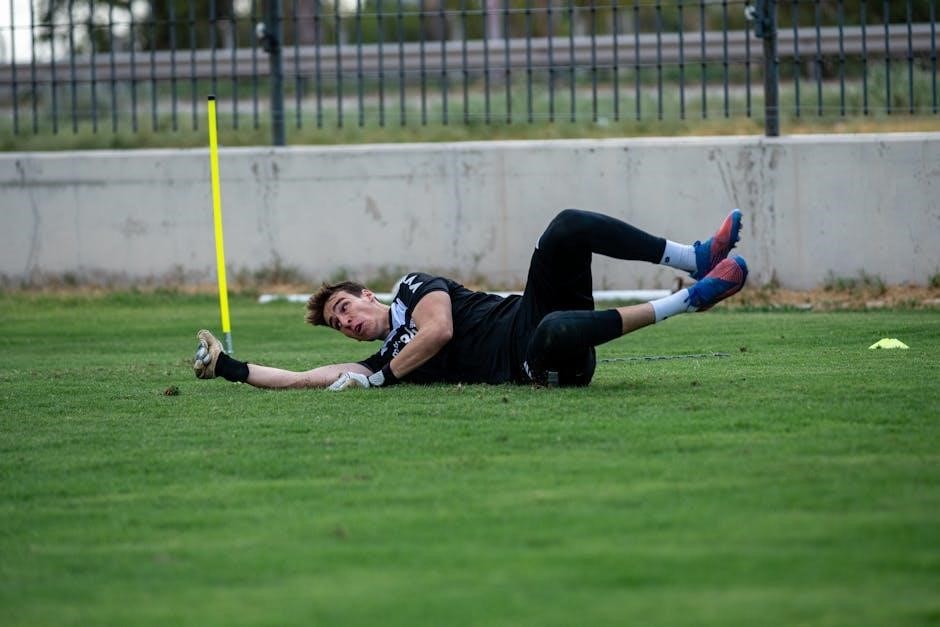
Creating a Training Schedule
A well-structured training schedule ensures consistency and progression․ Balance technical drills, physical conditioning, and recovery․ Periodization helps peak performance at key moments, preventing overtraining and enhancing long-term development effectively․
Weekly and Monthly Training Plans
A structured training plan balances technical drills, tactical awareness, and physical conditioning․ Weekly plans focus on specific skills like shot stopping and distribution, with 3-4 sessions․ Monthly plans progress these skills, ensuring peak performance during key matches; Coaches adapt schedules based on player needs, weather, and recovery requirements․ Periodization ensures balanced development, avoiding overtraining and enhancing long-term goalkeeper effectiveness․ Consistency and variation are key to sustained improvement and adaptability in competitive scenarios․
Periodization of Training Sessions
Periodization structures training into phases, focusing on specific skills and intensities․ It ensures balanced development by cycling through technical, tactical, and physical focuses․ Phases adapt to seasonal demands, avoiding overtraining․ Coaches design cycles to enhance peak performance during key matches․ This approach aligns training with long-term goals, optimizing a goalkeeper’s technical mastery, physical fitness, and mental preparedness while preventing burnout and injury risks․
